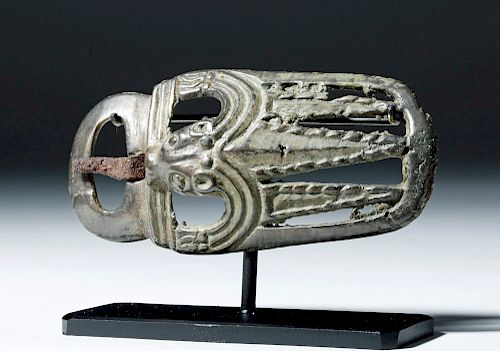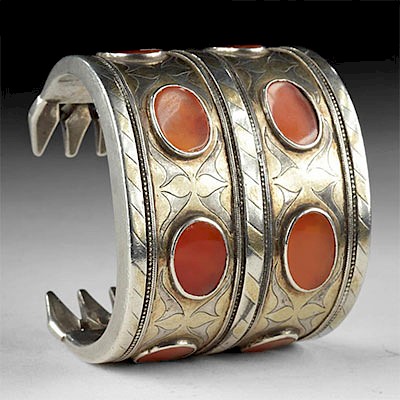5th C. Russian Bronze Buckle - Bear Form
Lot 51c
About Seller
Artemis Gallery
686 S Taylor Ave, Ste 106
Louisville, CO 80027
United States
Selling antiquities, ancient and ethnographic art online since 1993, Artemis Gallery specializes in Classical Antiquities (Egyptian, Greek, Roman, Near Eastern), Asian, Pre-Columbian, African / Tribal / Oceanographic art. Our extensive inventory includes pottery, stone, metal, wood, glass and textil...Read more
Categories
Estimate:
$1,800 - $2,700
Absentee vs Live bid
Two ways to bid:
- Leave a max absentee bid and the platform will bid on your behalf up to your maximum bid during the live auction.
- Bid live during the auction and your bids will be submitted real-time to the auctioneer.
Bid Increments
| Price | Bid Increment |
|---|---|
| $0 | $25 |
| $300 | $50 |
| $1,000 | $100 |
| $2,000 | $250 |
| $5,000 | $500 |
| $10,000 | $1,000 |
| $20,000 | $2,500 |
| $50,000 | $5,000 |
| $100,000 | $10,000 |
| $200,000 | $20,000 |
About Auction
By Artemis Gallery
Aug 6, 2019
Set Reminder
2019-08-06 11:00:00
2019-08-06 11:00:00
America/New_York
Bidsquare
Bidsquare : VARIETY SALE | Antiquities & Ethnographic Art
https://www.bidsquare.com/auctions/artemis-gallery/variety-sale-antiquities-ethnographic-art-4326
Around the world & back in time - be amazed at the treasures you will find. Antiquities from Egypt, Greece, Italy and the Near East, Asian, Pre-Columbian, African / Tribal / Oceanic, Native American, Spanish Colonial, Russian Icons, Fine Art, much more! All categories, all price ranges... Artemis Gallery info@artemisgallery.com
Around the world & back in time - be amazed at the treasures you will find. Antiquities from Egypt, Greece, Italy and the Near East, Asian, Pre-Columbian, African / Tribal / Oceanic, Native American, Spanish Colonial, Russian Icons, Fine Art, much more! All categories, all price ranges... Artemis Gallery info@artemisgallery.com
- Lot Description
Russia, Perm region, Perm Animal Style (Permian Animal Style), ca. 5th to 11th centuries CE. A beautiful buckle in the form of a bear head and clawed arms inside a rounded frame and with three spikes rising from his back. Cast as part of the frame is a rounded loop, below the bear's nose, to form a hook for a belt buckle or some other kind of attachment, possibly one for a saddle. Why the bear is a subject for this type of item is explained below. Note the strong details of the bear's head and claws, emphasized here over the rest of its body. Bright, flashing objects were worn as part of fashion at the time, designed to draw the eye and demonstrate the wealth of the wearer. Comes with museum-quality display stand. Size: 3.55" W x 1.6" H (9 cm x 4.1 cm); 2.1" H (5.3 cm) on included custom stand.
The Perm Animal Style is associated with a loosely culturally connected group of people known as the Finno-Ugric peoples who lived in west central Siberia, from modern day Perm north to the Arctic Sea. They freely took artistic influence from those who came before them, like the Scytho-Siberians, and from colonists from the west, like the Vikings, but developed their own clear style that archaeologists know from graves scattered throughout the taiga. Birds of prey, ungulates like reindeer, canines, and bears are abound in their iconography; human representations are also common. These zoomorphic designs seem to share some common culture with the fantastical animals of pagan Viking art, but with some major stylistic differences. Notably, like the Scythians who occupied much of this landscape before them, they tend to focus on individual elements of animals - beaks, feet, claws, mouths, and eyes.
Imagining the lifestyle of people in the vast regions of the north - both in taiga and in forest - animals hardy enough to live through the dark winters would have been of great interest and probably played major roles in their folklore as well as being human companions and fellow hunters (birds of prey), food sources (reindeer), and threats (bears and wolves).
This iconographic style had remarkable uniformity of design across a vast region and long time period. Although nearly all of our knowledge comes from grave goods, these items seem to have been extensively used in life based upon wear patterns (unlike some other cultures, where goods are produced solely to be placed in graves). They were probably worn on the belt of their owner in life, at a time (which continued into the medieval European period) when flashing, jingling decoration was in fashion. Today, as climate change causes the melting of the permafrost in Siberia, many of these archaeological sites are thawing (and threatened), presenting an opportunity to learn more about these elusive ancient people.
Provenance: private Los Angeles County, California, USA collection, formed between 1980 and 2000
All items legal to buy/sell under U.S. Statute covering cultural patrimony Code 2600, CHAPTER 14, and are guaranteed to be as described or your money back.
A Certificate of Authenticity will accompany all winning bids.
We ship worldwide and handle all shipping in-house for your convenience.
#117338Excellent form with clear details; slight corrosion to one end as shown (not the bear head end).Condition
- Shipping Info
-
All shipping is handled in-house for your convenience. Your invoice from Artemis Gallery will include shipping calculation instructions. If in doubt, please inquire BEFORE bidding for estimated shipping costs for individual items.
-
- Buyer's Premium



 EUR
EUR CAD
CAD AUD
AUD GBP
GBP MXN
MXN HKD
HKD CNY
CNY MYR
MYR SEK
SEK SGD
SGD CHF
CHF THB
THB















